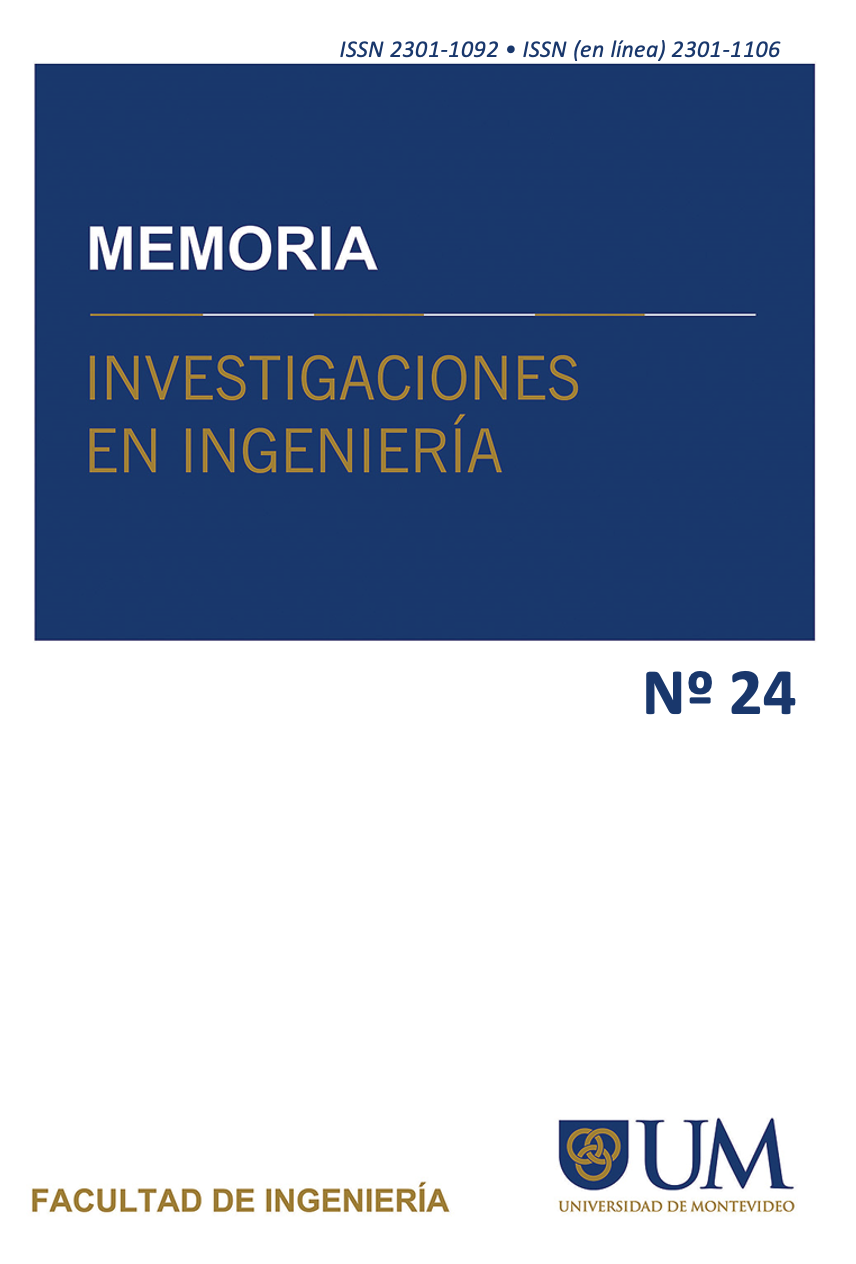Development of a Low-Cost Seismic Isolation System for Masonry Housing of 01 to 02 levels
DOI:
https://doi.org/10.36561/ING.24.3Keywords:
Seismic Protection, Low-Cost Isolation System, Concave Surface, Spherical IsolatorAbstract
The high cost of current anti-seismic devices makes it practically impossible to use them in housing buildings in low-income communities, leaving them exposed to seismic events. For this reason, the objective is to develop a low-cost seismic isolation system, made with inexpensive and accessible materials. In the initial stage, a mathematical model was developed, using its stability by means of phase portraits and the minimum potential energy principle. Then, the influence of geometrical parameters on the dynamic response of the system was analyzed. With the numerical implementation of the model, the structural response of the system was analyzed when subjected to earthquakes with different frequency contents, obtaining as a result a reduction of total accelerations that vary between a range of 4.5 times. The system was validated through the acquisition of the dynamic properties with seismographs, of an experimental model exposed to microtremors; and its comparison with the results obtained from the mathematical model. The proposed isolation system not only reduces the accelerations under the proposed earthquakes but also possesses the main characteristic of a seismic isolation system: period elongation.
Downloads
References
Bao, Y. y Becker, T, Three-dimensional double friction pendulum bearing model including
uplift and impact behavior: Formulation and numerical example. Engineering Structures, 2019,
vol. 199, p. 1-10.
Bethany, R. Ring of Fire: An Encyclopedia of the Pacific Rim’s Earthquakes, Tsunamis, and
Volcanoes, 2015, 1ra Edición. ABC-CLIO.LLC.
Cilsalar, H. y Constantinou, M. Behavior of a spherical deformable rolling seismic isolator for
lightweight residential construction. Bulletin of Earthquake Engineering 17, 2019: p.4321–4345.
Cilsalar, H. y Constantinou, M. Earthquake Engineering to Extreme Events Development and
Validation of a Seismic Isolation System for Lightweight Residential Construction, 2019,
Technical Report Multidisciplinary and multi-hazard earthquake engineering research center –
University at Buffalo.
Cilsalar, H. y Constantinou, M. Parametric study of seismic collapse performance of
lightweight buildings with spherical deformable rolling isolation system. Bulletin of Earthquake
Engineering 18, 2020: p.1475–1498.
de Luca, A. y Guidi, L. G. State of art in the worldwide evolution of base isolation design. Soil
Dynamics and Earthquake Engineering 125, 2019: p. 1-13.
Enrique, A. y Becerra, E. Los desafíos para la construcción en el Perú, 2018, Camara Peruana
de Comercio (CAPECO).
Foti, D. y Kelly, J. Experimental study of a reduced scale model seismically base isolated with
Rubber-Layer Roller Beari (RLRB), European Earthquake Engineering, 1996
Harvey, S. y Kelly, C. A review of rolling-type seismic isolation: Historical development and
future directions, Engineering Structures, 2016, vol.125, p. 521–531
Instituto Nacional de Estadística e Informática (INEI). Perú: Características de las viviendas
particulares y los hogares Acceso a servicios básicos, 2018, Censos Nacionales 2017: XII de
Población, VII de Vivienda y III de Comunidades Indígenas.
Jampole, E., et al. Full-scale dynamic testing of a sliding seismically isolated unibody house,
Earthquake Spectra, 2016, vol. 32, p. 2245–2270.
Jerry M. y Sthephen T. Classical Dynamics of Particles and Systems, 2004, 5th Edition. Chris
Hall.
Julio K. Manual para la Reducción del Riesgo Sísmico de Viviendas en el Perú, 2016,
Ministerio de Vivienda y Construcción.
Karl Astrom y Richard M. An introduction for scientists and engineers, 2009, Version
V.2.10b, Princeton University Press.
Katsamakas A. et al. Low-cost and sustainable seismic isolation with re-used tennis balls:
Lateral cyclic tests. 3th European Conference on Earthquake Engineering & Seismology, 2022: p.
- 10.
Katsamakas, A., et al Re-using tennis balls as low-cost seismic isolation devices: Experimental
Investigation, 3th International Conference on Natural Hazards and Infrastructure, 2022.
Katsamakas, A., et al. Experimental investigation of spherical rubber seismic isolation
bearings, 8th ECCOMAS Thematic Conference on Computational Methods in Structural
Dynamics and Earthquake Engineering, 2021.
Katsamakas, et al. Feasibility Study on Re-Using Tennis Balls as Seismic Isolation Bearings,
Frontiers in Built Environment, 2021, vol. 7, p. 1-18.
Katsamakas, et al. Shake-table testing of low-cost seismic isolation bearings based on rolling
rubber spheres, 3rd International Conference on Natural Hazards & Infrastructure ,2022.
Kelly, J. y Takhirov, S. Analytical and Experimental Study of Fiber-Reinforced Elastomeric
Isolators, 2001, PEER Report.
Kelly, M. Seismic isolation systems for developing countries, Earthquake Spectra ,2002, vol.
, p. 385–406.
Konstantinidis, D. y Kelly, J. Two Low-Cost Seismic Isolation Systems. 15th World
Conference on Earthquake Engineering, 2012: p.1-9.
Masum, M. y Ali Akbar, M. The Pacific Ring of Fire is Working as a Home Country of
Geothermal Resources in the World, 2nd Intenational Geothermal Conference IOP Conference
Series: Earth and Environmental Science vol. 249, 2019: p. 1 – 7.
Menga, N., Bottiglione, F. y Carbone, G. The nonlinear dynamic behavior of a Rubber- Layer
Roller Bearing (RLRB) for vibration isolation, Journal of Sound and Vibration, 2019, vol. 463, p.
-12.
Osgooei P., et al. Finite element analysis of unbonded square fiber-reinforced elastomeric
isolators (FREIs) under lateral loading in different directions, Composite Structures, 2014, vol.
, p. 164–173.
Roberto, V. Fundamental concepts of earthquake engineering, 2009, 1ra Edición. Taylor &
Francis Group.LLC
Tsiavos, A. et al. Large-scale experimental investigation of a low-cost PVC ‘sand-wich’
(PVC-s) seismic isolation for developing countries. Earthquake Spectra EERI, 2020: p 1886–1911.
Xiao, H., Butterworth, J. W. y Larkin, T. Low-technology techniques for seismic isolation.
New Zealand Society for Earthquake Engineering, 2004: p. 1- 8.
Published
How to Cite
Issue
Section
License
Copyright (c) 2023 Yalmar Carrera, Enrique Simbort

This work is licensed under a Creative Commons Attribution 4.0 International License.






















